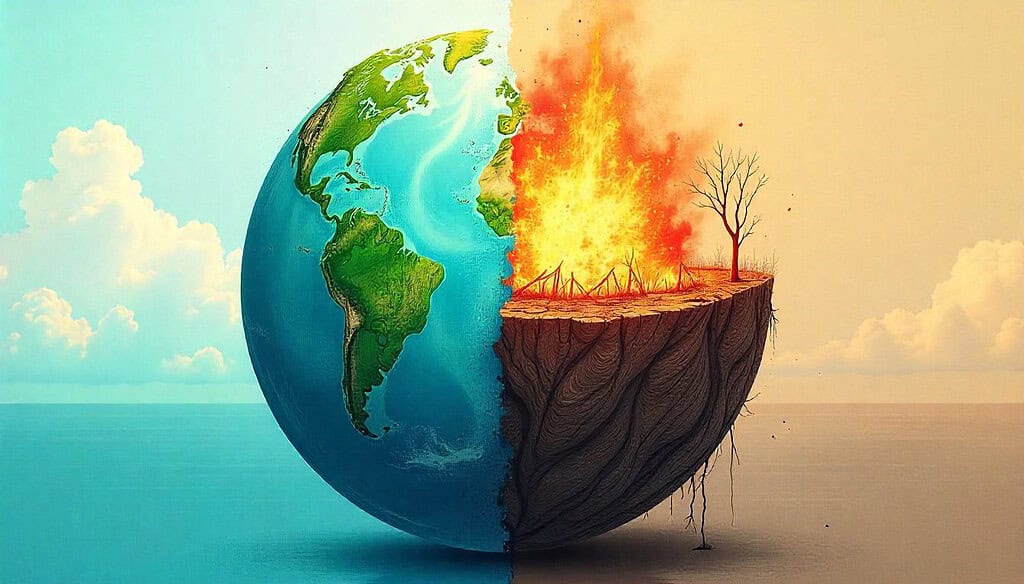Table of Contents
Danger of Environmental Damage: An Existential Threat

Environmental damage refers to the harm caused to ecosystems, biodiversity, and natural resources due to human activities such as deforestation, pollution, and excessive resource extraction. Over time, this damage has disrupted delicate ecological balances, threatening the planet’s ability to sustain life as we know it. Factors like the burning of fossil fuels, industrial waste, and plastic pollution have contributed significantly to the degradation of air, water, and soil quality. These actions, combined with the relentless exploitation of nature, have triggered severe consequences, such as climate change, loss of species, and ecosystem collapse.
The reason environmental damage poses an existential threat to our planet is that the earth’s ecosystems are interdependent. When one system is harmed, it can set off a chain reaction, affecting others. For example, rising global temperatures from greenhouse gas emissions have not only caused polar ice caps to melt but have also altered weather patterns worldwide, leading to more frequent and severe natural disasters. These events threaten food security, freshwater availability, and the livelihoods of millions of people.
Furthermore, environmental damage diminishes biodiversity, which is essential for healthy ecosystems. Loss of biodiversity weakens the resilience of ecosystems, making them more vulnerable to collapse and less able to recover from shocks. When ecosystems fail, the services they provide—such as clean air, water, and food—become compromised, directly impacting human survival.
In short, environmental damage is an urgent crisis that threatens the very foundations of life on Earth. If left unchecked, it could result in irreversible changes, making the planet inhospitable for future generations and jeopardizing the survival of many species, including humans.
Danger of Environmental Damage: All Hands on The Deck

Addressing the threat of environmental damage requires coordinated efforts at all levels of society, as the scale and complexity of the issue are far too great for any single entity to resolve. Governments must take the lead by implementing stringent environmental regulations and promoting sustainable development policies. This includes enforcing limits on pollution, investing in renewable energy, and protecting natural habitats. Governments also need to collaborate globally to meet climate goals and mitigate the effects of environmental damage that transcend national borders, such as rising sea levels and the loss of biodiversity.
Corporations play a crucial role as well, given their significant impact on resource consumption and waste production. Big companies must prioritize sustainable business practices, from reducing emissions to ensuring the ethical sourcing of materials. They need to adopt circular economy principles, where resources are reused and recycled, and minimize their contribution to environmental damage through innovative technologies and green initiatives. Businesses should also be transparent about their environmental footprint, holding themselves accountable to both consumers and regulatory bodies.
Wider society, including non-governmental organizations and local communities, must raise awareness about the importance of reversing environmental damage. Advocacy for green policies, participation in environmental movements, and community-led conservation efforts can help shift public opinion and encourage positive change. Societal support can also drive consumer demand for eco-friendly products, pushing businesses to adopt greener practices.
On an individual level, each person can contribute by adopting sustainable habits such as reducing waste, conserving energy, and supporting environmental causes. Small actions, when multiplied across the population, can significantly reduce environmental damage. Whether through lifestyle changes, advocacy, or mindful consumption, everyone has a part to play in reversing the harm done to our planet.
8 Ways A Person Can Help Against Environmental Damage

1. Reduce, Reuse, and Recycle
The principles of “Reduce, Reuse, and Recycle” are critical in the fight against environmental damage. By reducing consumption, individuals can significantly lower the demand for resource extraction, which often leads to deforestation, habitat destruction, and pollution. Overconsumption is a key driver of environmental damage, as it leads to excessive waste, energy use, and emissions. Reducing the amount of waste generated by making mindful choices, such as buying only what is necessary and avoiding single-use products, can have a lasting positive impact on the environment.
Reusing items instead of discarding them helps extend the life cycle of products, reducing the need for new raw materials. When individuals reuse, whether it’s through repairing broken items, repurposing old materials, or donating goods, they reduce the overall waste that ends up in landfills. This not only limits environmental damage from waste disposal but also conserves resources that would have been used to produce new goods.
Recycling, the final component, ensures that materials like plastics, paper, and metals are reprocessed and used again, preventing them from contributing to pollution. However, recycling systems need to be robust, and individuals must be educated on proper recycling practices to prevent contamination. While recycling has its challenges, it remains a vital step in mitigating environmental damage. By fully embracing these three actions, individuals can greatly reduce the strain they place on the environment and help curb the damage that unchecked consumption and waste can cause.
2. Conserve Energy
Energy conservation is a crucial practice for minimizing environmental damage, as energy production is one of the largest contributors to greenhouse gas emissions. Fossil fuels, which are still the dominant source of energy globally, release carbon dioxide and other pollutants into the atmosphere, accelerating climate change and contributing to environmental damage. By conserving energy, individuals can reduce their carbon footprint and lessen the demand for energy produced by harmful, non-renewable sources. Simple steps like turning off lights when not in use, using energy-efficient appliances, and improving insulation in homes can make a significant difference in the long term.
The overuse of energy also strains natural resources, as the production of electricity and fuel requires massive amounts of raw materials like coal, oil, and natural gas. The extraction and consumption of these resources lead to environmental damage, such as habitat destruction, water pollution, and air pollution. Conserving energy helps reduce this demand, thereby minimizing the negative impact on ecosystems and biodiversity.
In addition, energy conservation reduces the need for large-scale energy infrastructure projects, such as dams, mines, and power plants, which often cause severe environmental damage. By lowering energy consumption, individuals can also help delay or avoid the construction of new energy facilities that would further degrade the environment. Thus, energy conservation is not just about saving money on utility bills; it is a powerful tool for reducing environmental damage and mitigating the impacts of climate change.
3. Use Eco-friendly Products
Using eco-friendly products is an essential step individuals can take to reverse environmental damage. Eco-friendly products are designed to minimize their environmental impact, either through the materials used in their production or the processes involved. By choosing products made from sustainable, biodegradable, or recycled materials, individuals can reduce the demand for resource extraction, which often results in deforestation, habitat loss, and pollution. This shift can also help limit the environmental damage caused by traditional manufacturing processes that rely heavily on harmful chemicals and excessive energy use.
Another key benefit of eco-friendly products is that they often have a lower carbon footprint compared to conventional alternatives. Whether it’s organic clothing, biodegradable packaging, or energy-efficient electronics, these products are designed to reduce environmental damage throughout their life cycles, from production to disposal. Individuals who adopt these products contribute to reducing emissions and waste, which are major contributors to environmental damage on a global scale.
Furthermore, eco-friendly products often promote better waste management practices. For instance, biodegradable products break down naturally, reducing the burden on landfills and preventing pollution. This helps combat the accumulation of waste that contributes to environmental damage, such as the plastic pollution crisis affecting oceans and wildlife. By supporting businesses that prioritize sustainability and ethical production, individuals can drive demand for greener alternatives and push industries to adopt more environmentally responsible practices, ultimately helping to reverse the environmental damage caused by unsustainable consumption.
4. Minimize Water Waste
Minimizing water waste is a crucial step in preventing environmental damage, as freshwater is a limited resource that is essential for all life forms. Excessive water use places immense pressure on water bodies, depleting aquifers, rivers, and lakes, which can lead to the degradation of ecosystems. Water scarcity is already a major issue in many parts of the world, and it is exacerbated by inefficient use and wasteful habits. Individuals can play a vital role in minimizing environmental damage by adopting water-saving practices, such as fixing leaks, using water-efficient appliances, and reducing consumption in daily activities like showering or washing dishes.
Wasting water also contributes to energy consumption, as significant amounts of energy are required to treat, transport, and heat water. By reducing water waste, individuals can indirectly reduce the environmental damage caused by the energy needed for water processing. This, in turn, helps cut down on greenhouse gas emissions and reduces the overall environmental footprint associated with water use.
In addition, excessive water use often leads to pollution, as untreated wastewater can overflow into natural water sources, contaminating ecosystems and harming wildlife. Minimizing water waste helps prevent this form of environmental damage by ensuring that water resources are used more efficiently and responsibly. Ultimately, by valuing and conserving water, individuals contribute to the protection of ecosystems, the reduction of pollution, and the mitigation of environmental damage linked to water scarcity and mismanagement.
5. Support Renewable Energy
Supporting renewable energy is one of the most impactful ways individuals can combat environmental damage. The current reliance on fossil fuels for energy production has led to significant environmental degradation, including air pollution, habitat destruction, and the acceleration of climate change. Renewable energy sources like solar, wind, and hydropower offer a cleaner alternative, producing energy without the harmful emissions that contribute to environmental damage. By supporting renewable energy, individuals can help transition away from fossil fuels and reduce the negative environmental impacts associated with traditional energy production.
Renewable energy reduces the demand for harmful extraction processes, such as coal mining and oil drilling, which cause extensive environmental damage to ecosystems and landscapes. Such activities frequently result in deforestation, soil degradation, and water pollution. By advocating for and investing in renewable energy, individuals help protect these environments from further destruction.
In addition to reducing emissions and protecting ecosystems, renewable energy promotes sustainable development. Unlike finite fossil fuel resources, renewable sources are abundant and can be harnessed without depleting natural reserves. This means that supporting renewable energy helps ensure long-term energy security while minimizing damage to the environment. Individuals can contribute by choosing renewable energy options for their homes, supporting green energy policies, and investing in companies that prioritize clean energy. By making these choices, individuals help accelerate the transition to a sustainable energy future and mitigate the environmental damage caused by fossil fuel dependence.
6. Adopt Sustainable Transportation
Adopting sustainable transportation is a critical measure for reducing environmental damage, as the transportation sector is one of the largest contributors to greenhouse gas emissions and air pollution. The use of personal vehicles powered by fossil fuels generates significant emissions that contribute to climate change, smog, and environmental degradation. By choosing sustainable transportation options like walking, biking, carpooling, or using public transit, individuals can drastically reduce their carbon footprint and lessen the environmental damage associated with vehicle emissions.
Sustainable transportation also helps reduce traffic congestion and the need for extensive road infrastructure, which often leads to habitat destruction and increased pollution. Fewer cars on the road mean less environmental damage from the construction and maintenance of highways, as well as a reduction in noise pollution that can disrupt local wildlife. Individuals who adopt more sustainable transportation methods can help limit these negative impacts on the environment.
In addition, the rise of electric vehicles (EVs) offers a promising alternative to traditional gasoline-powered cars. EVs produce fewer emissions and reduce reliance on fossil fuels, contributing to the fight against environmental damage. However, even with EVs, the most sustainable transportation choices involve reducing travel where possible or opting for non-motorized options. By embracing sustainable transportation habits, individuals not only help mitigate climate change but also play a direct role in minimizing the environmental damage linked to urbanization, air pollution, and resource depletion.
7. Plant Trees and Preserve Green Spaces
Planting trees and preserving green spaces are powerful actions individuals can take to combat environmental damage. Trees play a crucial role in absorbing carbon dioxide from the atmosphere, thereby helping to mitigate the effects of climate change. Additionally, trees contribute to biodiversity by providing habitats for wildlife and supporting ecosystems that are essential for maintaining environmental balance. By planting trees, individuals not only reduce the atmospheric concentration of greenhouse gases but also help reverse environmental damage caused by deforestation and urbanization.
Green spaces, such as parks and nature reserves, serve as critical areas for both human and ecological well-being. These spaces help filter pollutants, reduce urban heat islands, and prevent soil erosion, which are all forms of environmental damage exacerbated by human activities. By protecting and expanding these green areas, individuals can preserve biodiversity and promote ecological stability. Furthermore, the preservation of green spaces ensures that future generations will continue to benefit from the essential services that natural ecosystems provide.
In addition to the ecological benefits, planting trees and preserving green spaces also improve the mental and physical health of communities by offering areas for recreation and relaxation. Encouraging community involvement in tree planting and green space conservation efforts fosters a sense of environmental stewardship and responsibility. Ultimately, these actions are essential to reversing the widespread environmental damage caused by human expansion and industrial activities.
8. Raise Awareness and Advocate for Change
Raising awareness and advocating for environmental change are vital steps in addressing the global threat of environmental damage. Many individuals remain unaware of the scale and urgency of the crisis, so spreading information and educating others is a critical first step toward collective action. When people understand the causes and consequences of environmental damage, they are more likely to change their habits, support green initiatives, and demand policy reforms from their governments.
Advocacy goes beyond individual actions and targets broader structural change. By pushing for environmental policies and regulations that prioritize sustainability, individuals can help influence governments, corporations, and communities to adopt practices that reduce environmental damage. For example, supporting legislation that encourages renewable energy, sustainable agriculture, or stricter pollution controls can create the systemic shifts needed to address the root causes of environmental degradation.
Social media, grassroots campaigns, and public demonstrations are effective tools for raising awareness and advocating for change. These platforms allow individuals to reach wider audiences and unite people around shared environmental goals. Advocacy efforts can also empower marginalized communities who are often most affected by environmental damage, ensuring that solutions are inclusive and equitable. In essence, raising awareness and advocating for environmental change are critical strategies for tackling environmental damage at both the local and global levels, fostering a collective responsibility to protect our planet.
Environmental Damage: Fight Continues in The Future

The fight against environmental damage is an ongoing challenge that will persist well into the future. As the impacts of climate change, deforestation, and pollution become more evident, efforts to mitigate these issues must be sustained and strengthened. Governments, societies, and individual persons all have critical roles to play in addressing environmental damage. Governments must continue to enact and enforce policies that regulate pollution, promote renewable energy, and protect natural resources. These efforts are essential for setting the foundation for large-scale change, as well as for holding industries accountable for their environmental impact.
Societies, including local communities and global organizations, must maintain their advocacy for environmental preservation. Collective action can influence public policy and push for greater corporate responsibility in minimizing environmental damage. Additionally, community-led initiatives, such as tree-planting projects, clean-up efforts, and sustainability education programs, can create localized improvements and foster a culture of environmental stewardship. Society’s engagement is crucial for driving broader awareness and encouraging more widespread participation in environmental protection.
On an individual level, each person’s daily choices can contribute to the larger fight against environmental damage. Simple actions like reducing waste, conserving water, and using eco-friendly products can collectively reduce the strain on ecosystems. Individuals can also amplify their impact by raising awareness, advocating for policy changes, and supporting businesses that prioritize sustainability.
The fight to reverse environmental damage will require continuous commitment from all levels of society. It is a shared responsibility that involves cooperation, innovation, and persistent efforts to create a more sustainable future. Though the challenges are immense, sustained actions by governments, communities, and individuals can slow down and eventually reverse the damage to our environment, preserving the planet for future generations.
Disclaimers: *This article is only for informational purposes.
**Do not make your important decisions based solely on the information provided in this article. Do your own research.
***Information in this article may vary or may get updated in the future.
Read More Science and Space Articles
- Eradication Of Poverty: 8 Critical Ways Science Helps
- Japan’s Space Program: Top 8 Incredible Achievements By It
- STEM Fields: 8 Important Reasons Why You Must Learn Them
- Making Your Kid Efficient At STEM Subjects: 8 Important Steps
- Making Your Kid Science Enthusiast: 8 Important Steps
- Becoming A NASA Aspirant: 8 Important Steps You Must Follow
- Top 4 Colored Rice That Are Superior to White Rice
- Top 8 Important Wellness Habits That You Must Follow
- Top 5 Amazing Whole Grains That Are Healthier Than Rice
- Indian Space Program: 8 Incredible Achievements
- China’s Space Program: 5 Amazing Accomplishments
- Oranges: 11 Incredible Facts About This Tangy Citrus Fruit
- NASA’s MOXIE Creates O2: Big Step Towards Mars Colonization
- Top 5 Amazing Properties of Time That Defy Common Sense
- 10 Factors for Emergence of Intelligent Life in The Universe
- Space Science: 6 Vital Reasons Why We Should Invest in It
- Solar System: 10 Astonishing Uniqueness of our star system
- Our Universe: An Incredible Journey of 13.7 Billion Years
- Top 6 Solar System Objects That Might Destroy Life On Earth
- Certain End of The Universe: 4 Forces of Nature to Watch Out For
- Big Bang: An Incredible Start of Universe 14 Billion Years Ago




